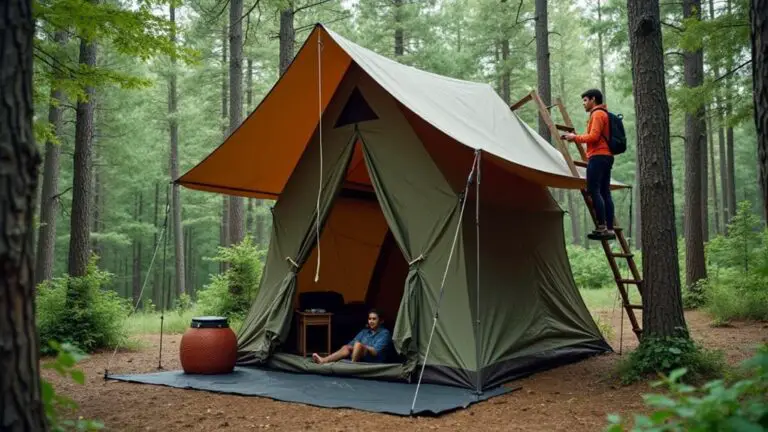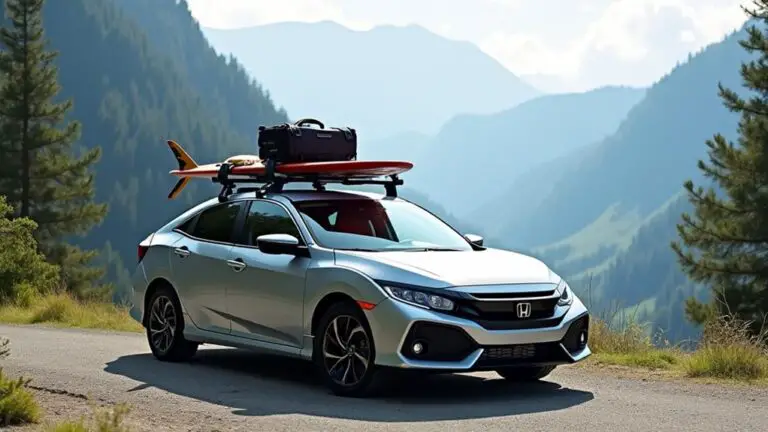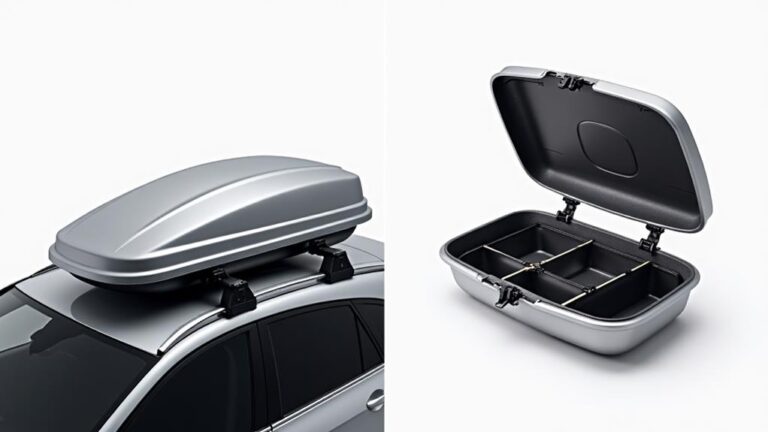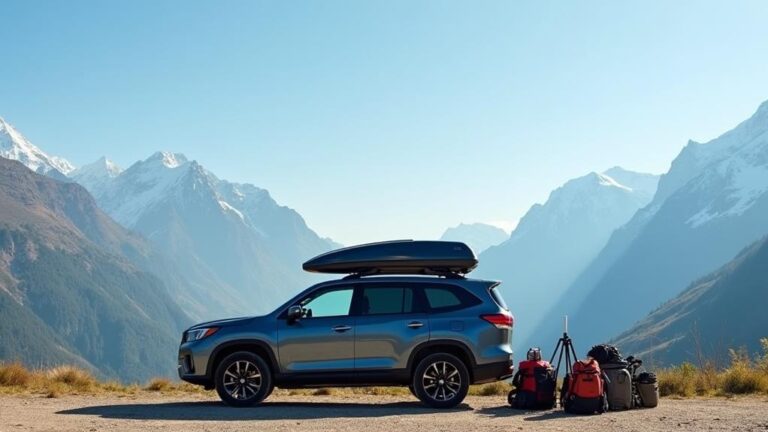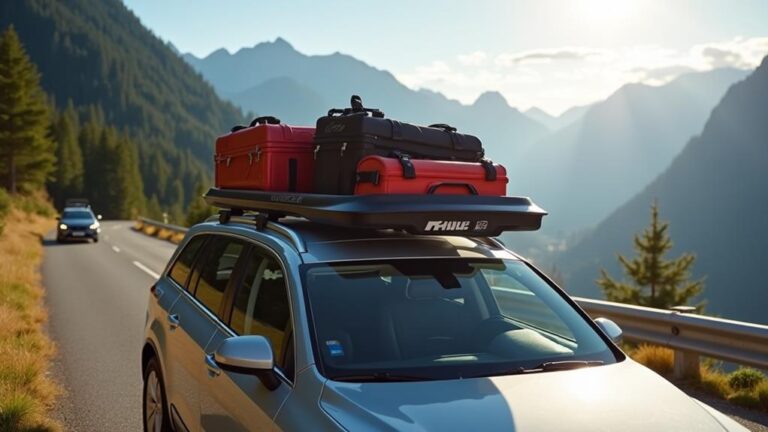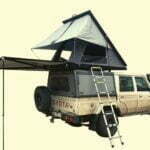You've likely encountered those 'less-than-ideal' camping situations where a conventional tent just doesn't cut it. Off-ground tents, with their elevated design, are changing the game for outdoor enthusiasts. Their sturdy construction, waterproof fabric, and UV-resistant materials can withstand harsh weather and heavy use. But what really sets them apart is their ability to provide excellent ventilation and keep occupants dry in wet conditions. As you consider your next camping trip, you might wonder: what other benefits do off-ground tents have to offer, and how can you maximize their functionality to enhance your outdoor experience?
Key Takeaways
- Off-ground tents provide elevated design for better ventilation and dryness in wet conditions.
- Durable materials and robust construction withstand harsh weather and heavy use.
- Built-in insect screens, windows, and doors offer excellent airflow and visibility.
- Adjustable legs or poles allow customization of height and angle on uneven terrain.
- Waterproof and UV-resistant fabrics and sturdy frames ensure longevity and durability.
Key Features of Off-Ground Tents
When shopping for an off-ground tent, you'll likely come across several key features that set these structures apart from traditional camping options.
Tent innovators have been driving the camping evolution by designing and developing innovative features that cater to different needs and preferences.
One of the most noticeable features of off-ground tents is the elevated design, which provides better ventilation and keeps you dry in wet conditions.
These tents often have adjustable legs or poles that allow you to customize the height and angle of the structure. This feature is particularly useful on uneven terrain.
Another key feature of off-ground tents is the use of durable materials and robust construction.
These tents are designed to withstand harsh weather conditions and heavy use. The fabric is often waterproof and UV-resistant, while the frame is typically made of sturdy aluminum or steel.
Additionally, many off-ground tents come with built-in insect screens, windows, and doors that provide excellent airflow and visibility.
These features make off-ground tents an attractive option for campers seeking comfort and convenience.
Setting Up the Tent
When setting up your off-ground tent, you'll need to choose a location that's flat and clear of any obstacles, such as rocks or tree branches.
You'll also want to guarantee the area is level and can support the weight of the tent and its occupants.
Once you've selected a suitable location, you can begin securing the structure by following the manufacturer's instructions for anchoring and stabilizing the tent.
Choosing a Location
Choosing a suitable location for setting up your off ground tent is crucial for a safe and enjoyable outdoor experience. As you begin site scouting, consider the terrain and potential hazards in the area. When evaluating the terrain, look for level ground, avoid low-lying areas that can collect water, and steer clear of slopes that can cause your tent to shift or topple.
| Terrain Evaluation | Considerations |
|---|---|
| Elevation | Avoid steep slopes |
| Water Flow | Avoid low-lying areas |
| Obstacles | Avoid overhead branches |
When evaluating a location, consider the surrounding environment and potential hazards such as nearby water sources, wildlife habitats, and overhanging branches. Verify that your off ground tent is set up at a safe distance from these hazards to minimize the risk of injury or property damage. By taking the time to carefully select a suitable location, you can guarantee a safe and enjoyable outdoor experience.
Securing the Structure
When setting up your off-ground tent, start by identifying the anchor points on the tent's frame.
These points are usually marked with reinforced stitching or metal rings.
Next, attach the tent anchors to these points, making sure they're securely fastened to the ground.
You may need to use additional tools, such as a hammer or mallet, to drive the anchors into the ground.
In addition to tent anchors, guy line systems also play a vital role in securing your off-ground tent.
These systems consist of ropes and stakes that help to distribute the weight of the tent evenly.
Sturdy Suspension Systems
A well-designed off-ground tent relies heavily on its sturdy suspension systems to maintain stability and structural integrity.
As you set up your off-ground tent, you'll notice the importance of these systems in securing the structure above the ground. The suspension system typically consists of tree anchors, ropes, and poles that work together to distribute the weight of the tent evenly.
When selecting tree anchors, look for sturdy options that can support the weight of your tent and withstand various environmental conditions.
You'll also need to verify that the rope tensions are adjusted correctly to prevent sagging or instability. Properly adjusted rope tensions will help maintain the structural integrity of the tent, even in windy or rainy conditions.
It's crucial to follow the manufacturer's guidelines for setting up the suspension system to achieve peak performance. By investing in a sturdy suspension system and following proper setup procedures, you'll be able to enjoy a safe and comfortable off-ground camping experience.
Water Resistance and Drainage
Water Resistance and Drainage
Typically, off-ground tents are subjected to various weather conditions, and having a water-resistant design is crucial to maintaining a dry and comfortable interior.
You'll want to look for tents made from waterproof materials that can withstand heavy rain and snow. These materials often feature Rainproof Coatings, which prevent water from penetrating the fabric. The coatings work by creating a hydrophobic surface that causes water to bead up and roll off.
The tent's seams are also a critical area to examine when it comes to water resistance. Look for tents with sealed seams or those that use a special type of tape to prevent water from seeping in.
Additionally, the tent's floor should be made of a waterproof material to prevent water from entering from the ground. A well-designed drainage system is also essential to prevent water from accumulating around the tent.
This can include features such as a sloping roof and a waterproof skirt that directs water away from the tent. By reviewing these factors, you can guarantee your off-ground tent remains dry and comfortable in wet weather conditions.
Ventilation and Airflow Systems
When considering an off-ground tent, you'll want to examine its airflow design to guarantee it effectively manages moisture and temperature.
A well-designed ventilation system should prioritize airflow circulation, allowing you to control the flow of air in and out of the tent. Natural ventilation systems, in particular, play a vital role in maintaining a comfortable interior climate, and you'll want to look for features such as strategically placed windows, vents, and mesh panels.
Airflow Design Considerations
Ventilation and Airflow Systems
Airflow Design Considerations
How do off-ground tent designers achieve ideal airflow to keep occupants comfortable and dry?
To address this, designers conduct ventilation analysis to understand how air moves within the tent.
This analysis involves studying air circulation mechanics, such as wind direction, air pressure, and the movement of air through the tent's fabric and vents.
Effective airflow design is vital to prevent moisture buildup and reduce the risk of mold and mildew growth.
When designing an off-ground tent, you should consider the following factors that affect airflow:
- *Adequate ventilation openings* to allow air to enter and exit the tent, reducing the risk of condensation buildup.
- *Air-permeable materials* that enable air to pass through the fabric, promoting airflow and reducing moisture accumulation.
- *Internal ventilation channels* that direct airflow through the tent, enhancing circulation and minimizing stagnant air pockets.
- *Wind-tunnel testing* to validate airflow performance and identify areas for improvement in the tent's design.
Natural Ventilation Systems
Considering the airflow design of an off-ground tent, you're likely to find that natural ventilation systems play a crucial role in maintaining a comfortable environment.
These systems utilize natural air flow rates to regulate temperature and humidity levels, thereby reducing the need for artificial cooling or heating. By cleverly designing the tent's structure, manufacturers can harness the power of natural ventilation, creating a more pleasant and healthy space for occupants.
Natural ventilation systems work by allowing air to flow in and out of the tent through strategically placed openings.
This creates a Ventilation dynamics effect, where warm air rises and is replaced by cooler air, maintaining a consistent temperature.
To maximize airflow, off-ground tents often feature mesh panels, adjustable vents, and breathable fabrics.
These features work together to regulate air flow rates, ensuring a constant exchange of air and preventing the buildup of condensation.
By incorporating natural ventilation systems, off-ground tent manufacturers can create a more sustainable, efficient, and comfortable living space.
This approach not only benefits occupants but also reduces the environmental impact of the tent.
Bug and Wildlife Protection
Camping off the ground can greatly reduce your exposure to bugs and wildlife, but it's not a foolproof solution.
As you consider off-ground tent options, think about the types of wildlife barriers and bug shields that will provide you with the best protection. Some off-ground tents come with built-in bug shields, such as screens or mesh panels, to keep insects at bay.
Others may have removable bug nets or curtains that can be installed for added protection. Wildlife barriers, like durable fabrics or reinforced materials, can also be incorporated into the tent design to prevent larger animals from getting too close.
When it comes to bug and wildlife protection, consider the following:
- Are you prepared to deal with swarms of mosquitoes or biting flies that can easily ruin your camping trip?
- Do you know how to react if a wild animal approaches your tent, or do you have a plan in place?
- Are you aware of the types of wildlife that are commonly found in the area you'll be camping in?
- Do you have the necessary gear to protect yourself and your belongings from potential threats?
Space and Comfort Options
When choosing an off ground tent, you consider the number of people it will accommodate, and manufacturers typically offer various sleeping capacity options to suit your needs.
You also evaluate the interior living space, taking into account factors such as floor area, peak height, and vestibule space. By examining these features, you can select an off ground tent that balances sleeping capacity with interior living space to create a comfortable environment for you and your companions.
Sleeping Capacity Options
Space and Comfort Options
Sleeping Capacity Options
Most off-ground tents cater to a range of sleeping capacities, from two to twelve or more people.
As you consider the ideal off-ground tent for your needs, you'll want to think about the number of people who'll be occupying the tent. This will impact your decision on the overall size and layout of the tent.
When evaluating sleeping capacity options, consider the following:
- You'll want to guarantee each person has enough room to sleep comfortably, without feeling cramped or claustrophobic.
- A good rule of thumb is to look for a tent with a slightly larger capacity than the number of people who'll be using it.
- This will provide extra space for gear and allow for more comfortable movement around the tent.
- Keep in mind that some off-ground tents offer compartmentalized sleeping quarters, which can be beneficial for larger groups or families.
Ultimately, the right sleeping capacity for you'll depend on your specific needs and preferences.
Consider the size of your group, as well as any comfort or luxury features you may require.
Interior Living Space
Beyond sleeping capacity, the interior living space of an off-ground tent substantially impacts your overall comfort and experience. When choosing an off-ground tent, you should consider the interior features that will make your stay enjoyable. A cozy atmosphere and relaxing ambiance can be achieved with the right interior design.
To create a comfortable interior space, consider the following features:
| Feature | Description | Importance |
|---|---|---|
| Peak Height | The highest point inside the tent, allowing you to stand up and move around | High |
| Floor Area | The total square footage of the tent's floor, providing space for gear and living | Medium |
| Windows and Vents | Providing natural light and ventilation to maintain a comfortable temperature | High |
| Interior Pockets | Storage compartments for keeping gear organized and within reach | Medium |
| Gear Lofts | Additional storage space for gear, keeping the floor area clear | Low |
These interior features will profoundly impact your off-ground tent experience. By considering these factors, you can create a comfortable and relaxing space that suits your needs.
Suspension Methods and Techniques
By getting off the ground, you're elevating your camping experience, and suspension methods and techniques play a crucial role in this setup.
To guarantee your off-ground tent remains stable and secure, it's imperative to understand the various suspension methods and techniques available.
Tent anchors and rope systems are critical components of suspension methods.
Tent anchors come in different types, such as stakes, screws, and sand anchors, each designed for specific terrain and conditions.
Rope systems, on the other hand, involve a network of ropes and lines that distribute the weight of the tent evenly.
Some key benefits of effective suspension methods and techniques include:
- Reduced risk of tent collapse or damage from strong winds or harsh weather conditions
- Improved ventilation and airflow within the tent, leading to a more comfortable camping experience
- Enhanced protection from insects, rodents, and other pests that thrive on the ground
- Increased stability and security, allowing you to relax and enjoy your camping trip
Portability and Storage Options
When considering an off-ground tent, portability and storage options are essential factors to evaluate.
You'll want a tent that's easy to transport and store, making it ideal for backpacking trips or long-distance travel. Off-ground tents often feature packable designs that allow you to easily carry and stow the tent, suspension system, and other accessories.
Look for tents with compact travel cases or bags that provide protection and organization during transport.
These cases should be durable, water-resistant, and have multiple compartments to keep your gear organized. Some off-ground tents also feature compression sacks or stuff sacks that help reduce the tent's size, making it easier to pack into your backpack or luggage.
When evaluating portability and storage options, consider the weight and size of the tent, as well as the materials used in its construction.
Look for lightweight materials, such as aluminum or fiberglass, that provide strength and durability without adding bulk. Additionally, consider the ease of setup and takedown, as this can impact the overall portability of the tent.
Safety Considerations and Precautions
Your safety is paramount when using an off-ground tent, and it's essential to weigh the potential risks and take necessary precautions.
Before setting up your tent, conduct a thorough risk assessment of the area to identify potential hazards, such as uneven terrain, inclement weather, and wildlife habitats.
When it comes to emergency preparedness, consider the following essential items:
- *A first aid kit with basic medical supplies and a manual*
- *A reliable means of communication, such as a phone or two-way radio*
- *A backup power source, like a portable battery or generator*
- *A evacuation plan and emergency contact information*
It's also pivotal to follow the manufacturer's instructions for setting up and using your off-ground tent.
Make sure you understand how to properly anchor the tent, and be aware of any weight or wind load limitations.
Additionally, always inspect your tent for damage before use, and address any issues promptly to prevent accidents.
Frequently Asked Questions
Can Off-Ground Tents Be Used in Extreme Weather Conditions?
You'll need a durable, weather-resistant shelter to withstand extreme conditions. When it comes to storm preparedness, look for a sturdy, waterproof design with secure anchoring and reinforced poles for maximum stability in harsh weather.
How Often Should Off-Ground Tents Be Inspected for Damage?
Imagine inspecting your gear after every single use – that's ideal, but unrealistic. You should check your fabric for wear and mesh for tears every 10-15 trips to verify it's still in great condition.
Can Off-Ground Tents Be Set up on Uneven Terrain?
When setting up on uneven terrain, you'll encounter challenges like rocky outcrops and elevation differences. To overcome these, you'll make elevation adjustments, using stabilizers or blocks to level the surface, ensuring a secure setup.
Are Off-Ground Tents Suitable for People With Mobility Issues?
You know seniors who struggle with stairs. Similarly, mobility issues often require easy access to comfortable spaces. Off-ground tents can provide senior comfort with ample entry room and flexible floor plans for effortless movement.
Can Off-Ground Tents Be Used for Commercial or Event Purposes?
When hosting events or festivals, you'll find that elevated spaces can be ideal for festival venues. Off-ground tents can be used for commercial or event purposes, offering unique experiences and versatile configurations for attendees.
Conclusion
As you consider your next camping adventure, remember that an off-ground tent can greatly enhance your experience. Can you imagine a more comfortable camping trip, with better ventilation, dry conditions, and protection from the elements? With its sturdy construction, adjustable legs, and built-in insect screens, an off-ground tent is the perfect choice for camping enthusiasts. Its durability and versatility make it an investment worth considering for your next outdoor excursion.
